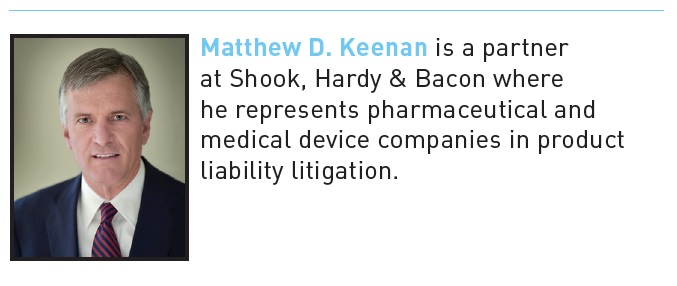
Sales Reps in the OR: Best Practices for Medical Device Manufacturers
by Matthew D. Keenan
Devoted viewers of “Seinfeld” may remember the episode where Kramer and Jerry are present in the operating room for an operation on Elaine’s ex-boyfriend Roy. While sitting in the viewing gallery, Kramer mishandles a Junior Mint that falls directly into the surgical field, landing in Roy’s surgical cavity. As in all “Seinfeld” episodes, hilarity ensues.
 In some circles, the notion of non-hospital staff in the OR is not engendering humorous plot lines. This practice is coming under increasing criticism by medical ethicists, patient advocates, and plaintiffs’ lawyers. One legal website decried the sales representative role, declaring they have “little oversight and scrutiny.” Another article questioned whether “surgeons rely too heavily on reps for technical expertise and assistance, to the potential detriment of patients.”
In some circles, the notion of non-hospital staff in the OR is not engendering humorous plot lines. This practice is coming under increasing criticism by medical ethicists, patient advocates, and plaintiffs’ lawyers. One legal website decried the sales representative role, declaring they have “little oversight and scrutiny.” Another article questioned whether “surgeons rely too heavily on reps for technical expertise and assistance, to the potential detriment of patients.”
And should a medical device end up in litigation, sales reps can present trouble no matter where they are. Considered by the plaintiffs’ bar as witnesses presenting low-hanging fruit, plaintiffs’ attorneys attempt to use them to advance the notion that sales trump safety. Not long ago the magazine Trial—which focuses on issues of interest to plaintiffs’ attorneys—featured a cover story offering strategies to “switch sales rep testimony to your advantage.” In it, the author advocates using the sales rep “to broaden the scope of potential fraud and misrepresentation claims.”
Add that to the growing list of challenges faced with sales reps.
So how does one navigate this landscape? And how does a medical device company mindful of risk management employ tools to keep this a non-issue?
What follows is a tutorial on the many issues raised when your employee is in the OR and should offer companies and their in-house counsel the best practices I’ve seen employed over the years. My goal is to empower companies to address these at the front end so when the bright lights of legal second-guessing descend, there is no controversy. these at the front end so when the bright lights of legal second-guessing descend, there is no controversy.
Overview
The issue has multiple levels of complexity—beginning with the hospital’s power of credentialing reps to even be on the property, but extending naturally to the authority of the surgeon, as the captain of the ship, and finally ending with the party most likely to be sued and therefore come under the greatest scrutiny—the device manufacturer.
As a practical matter, the primary focus should not be on legal liability. To be sure, there are outlying cases like the one involving a New York sales manager who had not graduated from high school yet attempted to fix a prosthetic hip for some three hours. It did not go well. Or the 2006 Ohio case in which a surgeon and a rep were ordered to pay a patient $1.75 million after botched brain surgery. In that case, the salesperson had wrongly assured the surgeon that bone cement was suitable for sealing a hole in the patient’s skull.
But these are unusual cases, obviously. While it is true that courts have largely insulated the rep from any legal duty—holding that no duty is owed to the patient, see, e.g. Kennedy vs. Medtronic, Inc., 366 Ill. App, 3d 298 (2006)—that does not mean that the legal implications should no longer be a concern.
Near the top of the list remains the optics presented. The simple question is pressed—why are they there, and are they selling something? To put a finer point on it—are they, as one website described, salespeople in the OR trying to squeeze profit at the expense of patient safety? Or, perhaps more disturbing, are they practicing medicine? One study by Jeffrey Bedard surveying medical device reps concluded that some 37 percent of reps believed they had been “excessively involved in an operation.” A Survey of Healthcare Industry Representatives’ Participation in Surgery: Some New Ethical Concerns, Jeffrey Bedard et al., The Journal of Clinical Ethics, Fall 2014.
At least one influential group doesn’t see an improper role for the reps. The American College of Surgeons firmly defended the role of the rep, asserting that relationships are helpful and reps “can provide surgeons with important technical information and assistance.”
What follows are what I could consider four “best practices” when it comes to reps in the OR.
1. Get the hospital and the rep on the same page.
To some reps stuck in an earlier era, vendor credentialing represents an illustration of bureaucratic red tape run amok. Today, these rules are the rep’s best friend. They serve as the first line of defense in legitimizing the presence of the company representative. Just as physician credentialing by the hospital adds a layer of patient safety, device credentialing affords similar protection. This may entitle the rep to have a badge defining the areas of the hospital where they may pass. It gives them cover.
Beyond the rep’s presence, it also signals to patients that the products themselves have demonstrated a level of clinical data satisfactory to the surgeons who may implant them. And as hospitals grow larger, so is the value of this endorsement.
But obviously the documentation must be thoroughly and meticulously completed.
2. Get the surgeon and the rep on the same page.
No one is going to be present in the OR unless the surgeon wants them there. In every case I’ve had, and there have been many, the surgeon explains the value of the rep and how patient safety is benefitted, not prejudiced.
With this viewpoint the surgeon has good company. The AMA’s Report of the Council on Ethical and Judicial Affairs has spoken to this. “Manufacturers of medical devices may facilitate their use through industry representatives who can play an important role in patient safety and quality of care by providing information about the proper use of the device or equipment as well as the technical assistance to physicians.” And the report added that doctors must “strive to prevent industry representatives from breaching patient privacy and confidentiality, and to seek to verify that they are properly credentialed and do not exceed the bounds of their training.”
Likewise, the Ethics Committee Town Hall noted that the relationships between surgeons and industry representatives are largely beneficial for both parties. “Industry representatives can provide surgeons with important technical information and assistance.”
Their presence may be dictated by the complexity of the surgery. As one surgeon noted, “They are probably there close to 100 percent in complicated cases such as spine surgery and joint implants.” “Why is that salesman in the operating room for your knee replacement?” Washington Post, November 14, 2016. The same is true for heart surgery with cardiothoracic surgeons placing pacemakers and defibrillators. In some implant cases, there may be as many as 50 parts that may be needed and hospitals cannot afford to stock extensive inventories.
Informed consent is an issue that runs throughout all this. The surgeon, in collaboration with the hospital, should be the entity to address informed consent. One journal suggested this prospect is best addressed in a pre-admission booklet that might explain the rep’s function as an expert on the equipment in use. See “Attendance of company representatives in the operating theatre,” British Journal of Theatre Nursing, Vol 7, No 1, April 1997.
Typical is this kind of consent: “I further consent to the admittance to the operating room of medical observers and other persons as may be permitted by the operating surgeon.” I have seen many other consents lacking such disclosure.
The device companies should facilitate these discussions with their hospitals now, as this issue grows in visibility.
3. Train the reps appropriately.
The reps must be cognizant of their proper role and their limitations. I have defended many device reps in litigation and know well the extensive nature of their training. My experience is that device-company hires are a highly skilled cross-section of the work force with demonstrated good judgment. And the appropriate interaction between and among physicians is a significant part of the training no matter where it takes place. Likewise, the devices, their indications, and basic steps to prepare the tool for use are part of the protocols.
Still, it is not as simple as declaring that “practicing medicine is left to the MD.”
More specifically, companies should underscore in writing that the appropriate boundaries must be respected. For example:
- the reps do not scrub in for the OR.
- patient confidentiality should not be compromised.
- reps should avoid the appearance of being a physician, so, for example, they should avoid the surgeons’ lounge and other venues typically limited to hospital personnel.
- reps are present to assist with questions about the product.reps are present to ensure the right product options are available for the surgeon.
- reps must know the DFU/IFU,1 including the indications, and how to assemble and use the product.
- reps should not exchange e-mails or text messages during the surgery unless it is specific to advancing patient safety.
To an outsider, there may appear to be shades of gray here. But determining the boundaries will help to ensure that the reps will not practice medicine. The AMA says it best: “Participation by industry representatives should not be a substitute for training of the physician that is necessary for safe and effective use of medical equipment and devices.”
4. Be ready when litigation arises.
Litigation involving Class Two medical devices continues to proliferate. In pretty much every case I’ve seen, plaintiff’s counsel questions the implanting doctor about the rep and his or her role in the OR. The essence of the suggestion by the plaintiff’s attorney is that the rep is present to influence the company’s best interests, not anyone else’s. The implanting doctor should be able to defeat this notion with a few basic assertions:
- reps are only present at the request of the surgeon;
- they help manage inventory and ensure the surgeons have what they need; and
- depending on the surgery, the applicable devices can be numerous and often not determined until the operation is underway. The surgeon cannot depend on his or her scrub nurses to know these products and have them available.
Conclusion
Adhering to a few common-sense best practices will serve medical-device companies. Even then, when a product finds its way to litigation, the second guessers will be in abundance. Ultimately the implanter should give manufacturers protection, along with a sensible policy from the company clearly laying out dos and don’ts for the reps that should provide guidelines on how to make this relationship productive.
[1] Directions for Use/Instructions for Use
Update Magazine
July/August 2017










